► The best 4×4 that’s not a Defender
► G-Class, Wrangler and Jimny get muddy
► Just be glad these cars still exist
Growing up on a farm in North Yorkshire, I got used to mud. Mud, along with oily puddles, old fence posts, barbed wire and baler twine, stacks of bald tyres, blue plastic fertiliser bags, a tractor that hadn’t started in a decade and a filthy farm dog that slept in the shed. Basically, all the stuff Countryfile doesn’t show you on Sunday-night telly.
It’s in this environment that a tatty old Land Rover 110 looks perfectly at home, covered in cow muck, the grey fabric interior turned a pale pastel beige by the caked dirt. Farmyards were the birthplace of the modern 4×4. But then – like amphibians crawling out of the primordial sludge – off-roaders left behind the muddy farms and evolved to live on the school run, becoming SUVs, crossovers, soft-roaders and the Lamborghini Urus. Technically still 4x4s, yes, but without the smell of sheep dip and red diesel.
This has been a trend for the last 40 years, but that doesn’t mean all off-roaders have now gone soft. Just as there are still amphibians out there, living in ponds, stubbornly refusing to become mammals, so too there are still proper off-roaders, boxy and heavy, capable of towing a JCB out of a swamp if required. In a world full of front-drive RAV4s and CR-Vs, that clarity of purpose is admirable.
And that’s why, if you’re a fan of proper off-roaders, I can confidently predict two things. One: you’re dreading the arrival of the new Land Rover Defender, knowing in your heart that it’ll be an Evoque knock-off with an optional 29-speaker Meridian hi-fi and no power take-off. And two: I reckon you’ll be exceedingly glad that these three cars exist. All recently arrived in the UK, all are proper 4x4s with old-fashioned ladder chassis, low-range gearboxes and jacked-up ground clearance. All three sacrifice refinement in the name of mud-plugging ability, and are proud of it.
So let’s go and find some mud.
Our guide: best electric SUVs
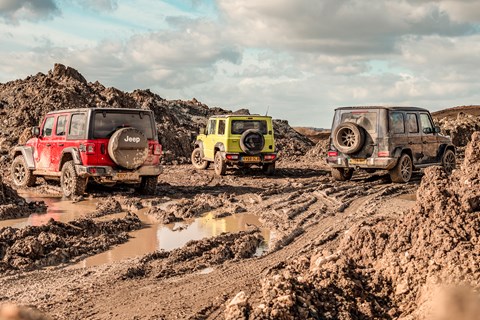
The cars
When you slam the door of the new Suzuki Jimny, the whole car rocks from side to side. That’s partly because the door is a pretty big percentage of the entire bodywork; and partly because the suspension is rigid axles attached to lovely, long-travel, Slinky-spring coils – basically a 30-year-old Land Rover Defender set-up. That wobble tells you everything you need to know about this car’s off-roading aspirations.
The Jimny has been an unlikely sensation since its international launch last year, already developing something of a cult following. I was agnostic until I met it in the metal. It’s just so instantly appealing, so blunt and boxy, so artless and honest. It’s something to do with the stance, the way those plastic wheelarches frame the knobbly wheels; and the roofline, with its rain-gutter rim, like a hat. The styling is expressive, like a children’s TV character – it’s a cartoon off-roader.
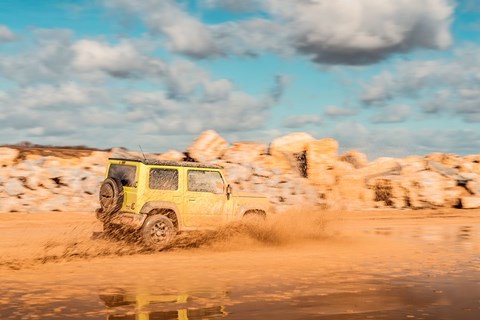
Next to it the new Jeep Wrangler four-door looks like a stretch limo. This too is a modern update of an old model – in this case, one that dates back to the American Civil War. Sorry, I mean 1941. But don’t let the derivative looks fool you – this latest JL series is also completely new, with a revised and reinforced ladder chassis, stronger axles, aluminium doors, wings and bonnet, and a fancy lightweight magnesium tailgate. It’s longer and wider than the outgoing JK model.
The interior has been updated with a touchscreen and modern connectivity, and while you can’t see it in these pictures, the rollover bar hidden beneath the removable hardtop has also been revised and strengthened. Much has been made of the fact that you can ‘easily’ fold down the JL’s windscreen, compared to the outgoing JK, but I quickly discover it’s still a fiddly job, involving the removal of bolts and the windscreen wipers, so we leave it up. That will later prove to be a blessing.
And our third car is the Mercedes G-Class – or G-Wagen as I insist on calling it (they’ll be calling the Unimog the U-Class next). Like the others, this is a modern re-imagining of a classic, but the G takes things to a whole new level, defying all modern conventions of mass production. Still hand-built in Graz, Austria, it has a new alloy body, new ladder chassis, new engines, a new nine-speed gearbox and new suspension and steering – still a rigid axle at the back, but with new double wishbones at the front for better road manners.
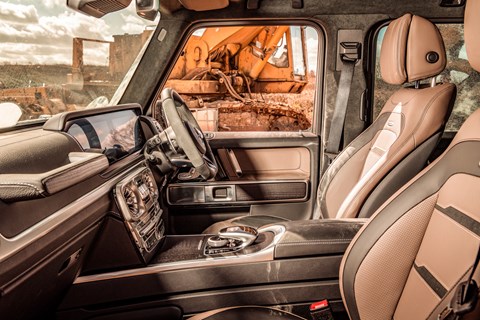
The decision to stay true to the G-Wagen’s 40-year-old identity, rather than reinvent it as a softy SUV, cost Mercedes a lot of time and money. Those proud indicator pods on the front wings, for example – rumour has it Mercedes spent €5 million getting that design detail through modern collision safety tests. This premium rebirth is reflected in the price: the little Jimny you see here costs £18,649; the 2.2 turbodiesel Jeep is £49,640; but the 577bhp biturbo V8 AMG G63 you’re looking at costs £143,305. That’s almost Bentley Bentayga money.
‘It will demolish anything in its path’
So let’s start in the G-Wagen, as we begin to explore the humongous quarry we find ourselves playing in working in today. Everything about this car is extraordinary, even climbing in. Engineers apparently obsessed over the feel of the pushbutton door handles – their hard, mechanical ‘clack’ is a delightfully retro first touch for a brand new car. Then a hefty step up, like climbing into a tractor, and the door needs a big Transit van-style slam to close behind you.
The interior is surprisingly intimate, and surprisingly bling, with lots of polished alloy and delicate-looking air vents. There’s an incongruity here, between the farmyard promise of the exterior and the luxury saloon dashboard; and between the upright windscreen, with its thick pillars (it’s like looking out of a concrete bunker) and the (optional) flat-bottomed AMG sports steering wheel. Even the engine noise: you expect a diesel clatter, and out comes a mighty V8 burble like a NASCAR.
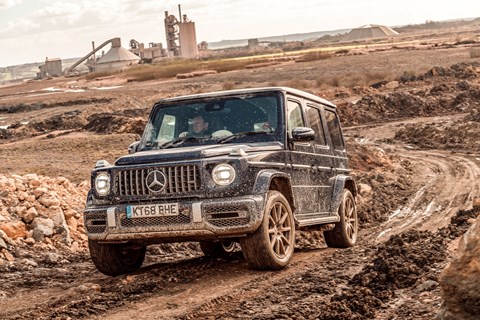
Cutting a gnarly trail (to use the correct 4×4 terminology) is always the best bit of off-roading – leading the way through uncharted mud, fording streams of unknowable depth, it’s the anticipation of what you might encounter that’s so thrilling, even in a quarry. So we lead the way in the Mercedes, with the eight-foot-tall Ben Pulman folded into the Jimny behind and James Taylor following in the Jeep at the rear. We’ve engaged the G-Wagen’s lockable diffs, controlled by three massive buttons in the middle of the dash – no delving into obscure touchscreen sub-menus with the G. With the diffs locked for maximum traction, we now have the off-roading capability of a Chieftain tank and the turning circle of an InterCity train.
We lead the trio of cars up a steep, deeply rutted bank, uncertain where it leads or even if it’s actually scalable by a mere car (all the tracks here were created using gigantic quarrying machines). What the hell, we launch up it anyway: the V8 roars into life, and the whole car starts squirming as we fight our way up, all four wheels now clawing at the mud, 627lb ft of torque tearing at the surface to scramble and kick our way up the slope. I’m sawing at the wheel, teeth gritted, and it’s so steep I can’t even see where we’re going over the blunt nose. The G-Wagen hauls us to the top, triumphant… Then I look in the mirror and find the Jimny directly behind, as if it’s followed me into a multi-storey car park. Wherever the Mercedes can go the Suzuki can follow. The Force is strong with that one.
We quickly discover the G-Wagen will demolish anything in its path, and torque is its weapon of choice: with all the diffs locked, it can just thrash all four wheels into the ground until they bite on something. At first I thought the road tyres would hold it back, but even when the tread is smothered with wet clay, that ability to churn the ground like a supertanker spinning its propellers means nothing can stop it.
‘Tactile, direct and mechanical’
Climbing out of the G and into the Jimny is a laugh. Suddenly the Suzuki doesn’t feel like an off-roader at all – you climb down into the driver’s seat, instead of up. Inside the dashboard is like the exterior – pleasingly angular, the dials boxed in, a homage to the ’80s. That’s what I love about the Jimny – its consistency.
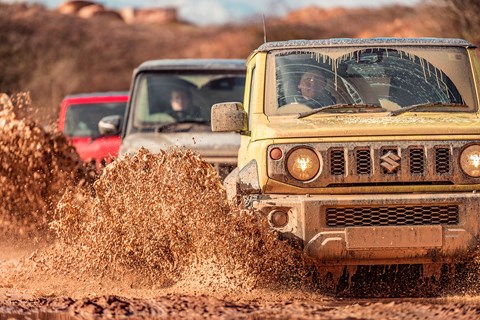
So, the weighting of the pedals, the feel of the gearchange, the noise of the engine, everything feels analogue and manual. While most modern manufacturers tune out noise and vibration until you feel like you’re inside a jelly, the Jimny feels tactile, direct and mechanical. I admit, on the road that means transmission drone and wind noise. And those soft springs – it’s like sharing an old spring mattress with a fidgety partner. But off road, the Jimny feels tough, defiant and full of character, like a old goat.
So, clunk the long gearlever into first, clunk the even clunkier transfer-box lever into low range, and set off at a crawl. Second gear is walking pace. Third is a brisk stroll. The 1.5-litre petrol engine is no firecracker, putting out just 100bhp, but the 96lb ft of torque, cranked through such low gearing, is still very effective.
Plus, the Jimny has the advantage of low weight – just 1435kg, less than half the G-Wagen’s 3200kg. Low range, low weight and low-tech suspension mean the Jimny is adorable but flawed on the road; but if you have any excuse at all to venture onto some mud (sheep farmer? Highland gillie? SAS soldier? Utility pole surveyor? School football coach?) then this car could replace Shep as your faithful new friend.
‘Few cars could pull off battleground chic’

By now, we’re having so much fun we’re in a slightly impulsive mindset: ‘Let’s see if they’ll go over that hump! Let’s drive up that cliff! Let’s cross that axle-deep quagmire!’ As each car tackles the obstacle, the other two drivers spectate – there’s something stupidly fascinating about a car wrestling its way through a bog. It’s the gleeful anticipation of someone getting stuck.
It is in this spirit of reckless enthusiasm that we decide to remove panels from the Jeep’s roof. While the windscreen remains fiddly, the black plastic roof comes off easily in sections. We try fording a deep lake of muddy water like this, and it works okay. Until, that is, we go a tiny bit faster.
Unfortunately, thanks to the laws of chaos theory, butterflies in Texas causing storms in the Pacific etc, this minuscule increase in speed causes a gigantic surge of muddy water to be lifted up off the Jeep’s nose and flung into the open roof like a tsunami of melted caramel.
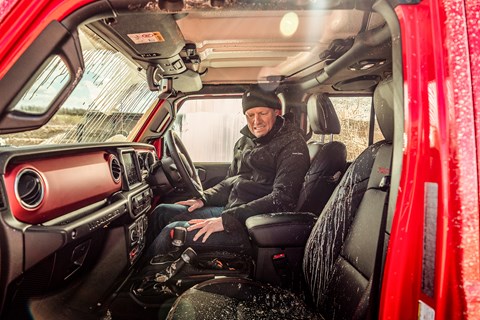
My face dripping with mud, at first I am shocked. Then I laugh. Then I am horrified – the interior of the Jeep looks like an explosion in a biscuit factory. How the hell is Ben Pulman going to explain this, when he gets the blame for it? And then I look again, with the eyes of a committed off-roader: actually, the cockpit looks quite cool. Few cars could pull off battleground chic as well as the new Wrangler. Where the plush, carpeted interior of the G-Wagen would look defiled, the Jeep’s back leather interior (with optional rubber Mopar Slush Mats on the floor) just looks appreciated, like an old pair of wellies. The Wrangler even has a Wash Out Interior featuring one-way floor drain valves so you can hose it out. Proper job.
Still, there’s no escaping it, the new Wrangler makes no sense on any rational level. Despite the JL revisions, it’s not particularly roomy inside, the new paint-finish dashboard is weirdly upright and fussy, and the plain white plastic of the detachable roof, seen from the inside, feels horribly cheap. Dynamically it’s a heavyweight – out on the road, the fat Goodrich all-terrain tyres give it an easy, compliant ride, but in corners it’s like steering an overloaded wheelbarrow. On the plus side, the new 197bhp 2.2-litre turbodiesel is smooth, reasonably quiet and not dreadfully slow.
Overall, a £45k Land Rover Discovery Sport makes much more sense as a 4×4 family car… but like the Jimny, that kind of argument is meaningless. The Jeep has real presence, especially in this off-roader Rubicon four-door spec. And in the mud, it’s another hardcore performer. It’s closer to the Mercedes than the Suzuki in the way it climbs in and out of muddy holes – it’s big and heavy, with an eight-speed automatic, so the action feels more removed compared to the hands-on Jimny. The turbodiesel can’t match the G-Wagen’s petrol V8 for outright muscle, but when you lock the Jeep’s diffs with buttons on the dash, and tug the notchy transfer-box lever into low range, it will rev, churn and dig its way through anything to drive you on.
We spend all day in the quarry and by the end of it there’s so much mud stuck to the cars we need a shovel, not a jet wash. Inside, the carpets are caked, the seats are brown and there are handprints all over the dashboards and steering wheels. They look magnificent.
And throughout our day of intrepid off-roading, we never get stuck once, despite trying quite hard. All three squelch, ford and climb everything in their path – a testament to their shared commitment to off-roading prowess and proper 4×4 chassis. By taking such a stubbornly traditional route, in the face of the soft-roader revolution, they not only continue a long line of filthy farm vehicles, they also have character by the shovel-load. Amphibians that make you fall in love, as well as crawl out of swamps. Land Rover take note.
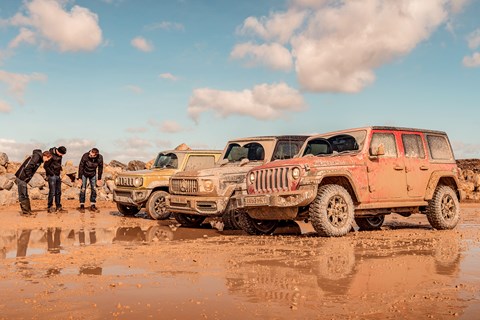
The specs
Suzuki Jimny
Price £17,999 (£18,649 as tested)
Powertrain 1462cc 16v four-cylinder, 100bhp @ 6000rpm, 95lb ft @ 4000rpm
Performance 12sec 0-62mph (est), 90mph
Efficiency 35.8mpg, 178g/km CO2
Jeep Wrangler Rubicon 4-Door
Price £48,405 (£49,640 as tested)
Powertrain 2143cc turbodiesel four-cylinder, 197bhp @ 3500rpm, 332lb ft @ 2000rpm Performance 10.3sec 0-62mph, 99mph
Efficiency 36.2mpg, 206g/km CO2
Mercedes-AMG G63
Price £143,370 (£145,755 as tested)
Powertrain 3982cc 32v V8, 577bhp @ 6000rpm, 627lb ft @ 2500rpm
Performance 4.5sec 0-62mph, 137mph
Efficiency 21.4mpg, 299g/km CO2
And coming up…
We’ll be revisiting this test with the all-new Defender.
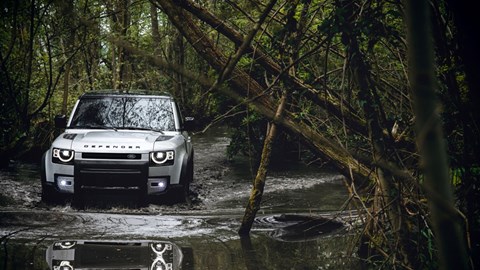
As expected, it represents the biggest shake-up in the model’s 71-year history, with highlights including an all-new platform, a wide range of engines, new technology and significantly increased dimensions. Production has also moved from Solihull to Slovakia.
Three-door 90 and five-door 110 versions of the new Defender have been confirmed so far, with the 110 on sale now at £45,240. Land Rover indicates that the 90 will be ‘around £40,000’ when it arrives shortly, and a range of commercial variants will start from £35,000 plus VAT. More info this way…